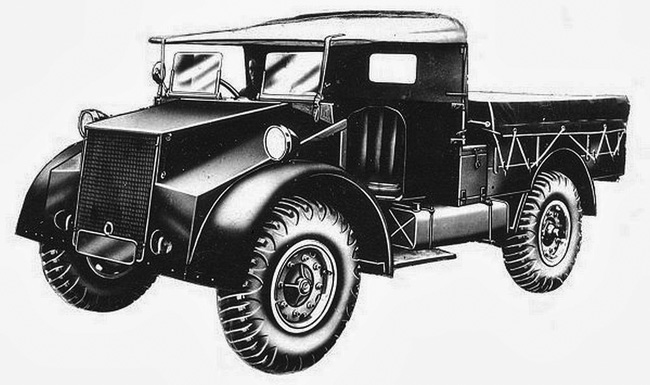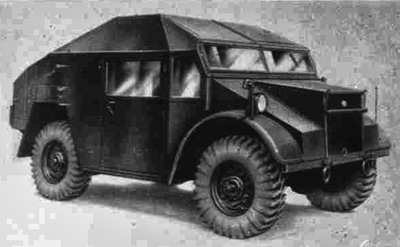Guy Quad Ant (1938)
 Artillery Tractor, 4,000 produced 1939-1944
Artillery Tractor, 4,000 produced 1939-1944
The 4x4 Guy Quad Ant was the best seller of the company in WW2. Answering 1937 specification for a 4x4 prime mover for the 25-pdr howitzer, complete with crew of 5 and ammunition limber, protected against chemical attacks, the vehicle was accepted in 1938 and ordered in growing numbers. Many were lost in France in the summer 1940 while with the BEF but they soldiered in all theaters where the Royal Artillery Regiments were deployed until 1944 when production ceased. In between, both the Ant and Quad Ant production were moved to Karrier whereas Morris produced many more based on the C8 chassis. Some were also sold aboard postwar.
Development

The 1935 2x4 Guy Ant
Guy Motors Limited was created back in May 1914, at the eve of the great war by Sydney S Guy to start producing utilitarian vehicles at Fallings Park factory, Wolverhampton, until it closed in 1982. Guy did not started his business without experience as he was the former manager at the Sunbeam factory. The company first produced a 30cwt lorry which innovated by using a new type of light pressed steel chassis instead of heavy rolled steel, making the vehicle much nimbler. The structure was intended to take advantage of the weak engines of the time to to cross-country work. The company aimed at the needs of the Royal Army at the time. The Guy Lorry hence met some success, until by 1915 the company fell under the direct control of the War Office and that of the Ministry of Munitions, to concentrate on military vehicles, aespecially ammunition carriers to the rear lines artillery batteries. Guy's company flourished and expanded, but post-years were crushing as the need for military vehicles ended abruptly.
The commercial market for off-road vehicle was limited so Guy started to look at export, but also diversified its range to saloon cars as well as buses and conventional lorries.
In 1928 Guy associated with Vickers to produce 100 Guy-Vickers armoured cars (Indian pattern) provided for the Indian Gvt. still seeing action against the Japanese in WW2. The same year the company ahd taken control of Star Motor Company. In 1930 however, the Road Traffic Act that all lorries up to 50cwt were to be limited in speed to 30mph and 20mph beyond, which was in addition married with a new punishing taxiation. This pressed Guy to concentrate on lighter goods vehicles. In 1933 the Guy Arab bus became a stunning 2-decker success produced for 20 years. The Wolf truck chassis, a two tons model was launched, using a lot of lighter, albeit more expensive materials but was so efficient on the long run it was very profitable. This success was followed by the 3/4 ton Guy Vixen truck, powered with a Meadows 3.3 litre 4-cyl., even more widely sold. This enabled the company to resist the post-1929 crisis.

The War Department meanwhile issued specifications for a new four-wheeled general service truck in 1934 and the next year, Guy Motors competed with its 2x4 prototype Guy Ant. This vehicle had a short wheelbase and was rated as a 15cwt truck. Trials took place by the Army at Llangollen, Wales. It was good enough for that 150 were ordered. It was proven capable tacked high gradients while fully loaded and still moved in deep soft terrain. It was assembled quickly with components from the whole range of Guy Motors and beyond, tyres from the Wolf and Vixen, axles from the Wolf, engine and cab panels from the Otter, its 6-ton lorry.
In 1937 the War Department issued new specifications for an off-road 4x4 wheeled field artillery tractor and Guy started again from the Ant chassis, creating the Guy Quad-Ant. Unlike the previous vehicle, it protected the driver, commander and 4 crew in a new boxy all-steel body. It was still unarmoured in the strict sense however. Again, trials took place in 1938 and the Army was impressed, ordering 444 Guy Quad-Ants by November 1938. The first arrived in their units by August 1939. However knowing Guy's hand built methods, the Army went to Morris as the war started, with an order to produced the same vehicle on the base of its C8 4x4 truck. The latter via the Nuffield group couduld mass produce the vehicle, making it the primary Royal Artillery moved with 10,000 C8 quad field tractors on order.
Design of the "Beetle Back"
Chassis and general design

The chassis used essentially a modified variant of the previous Ant with reinforced, but still light pressed steel chassis beams cxreating a latter on which was bolted the main body. As said above, it borrowed its roadwheels and axles to other vehicles, but there were many design specifications. The full enclosed body was not for protection against bullets, although they could stop some low velocity ones at certain angles due to the 5 mm plates, but it was specified to be very easy to wash down in case of a mustard gas attack, very much a concern in 1939. The dome-shaped roof also helped this by having an air collector with filters. This was perhaps the world's first "NBC" vehicle in the British Army for that matter. The angled steel roof plates were not there to increase steel thickness but just to let spray water or rain to runoff and decontaminate it.

The 25-pdr field gun
On the back of the roof the hull shape was done accdoringly to be able to house the 25 pdr gun own cartwheel base and rook rack. Still there was no aid to have these "unpacked", and the gun crew had to deal with bulk and weight each time. There was eventually changed as the gas attack was no longer proirity and the rear hull was now fitted with a tubular roof rack in order to be loaded with spare tyre and the crew's own gear. Another interresting perk was its internal winch running from the engine transmission under the floor and at the rear, which could be use for towing anything or be plassed under rollers to be used as unditching cable both from the sides or front.
Mobility
The Quad was a compact vehicle at 4.49 m (177 inches) long for 3.327 kg (7.320 lb.) still, and powered by a four-cylinder Meadows 4ELA rated for 3.686 cm3 (143 cubic inches) displacement, which was liquid cooled and provided with a carburettor. I was rated for 60 horsepower at 2600 rpm. It was connected to a 4-speed gearbox with a single speed transfer case. In addition to power its lamp it had a an Electrical system rated for 12 volt. The Brakes were Mechanical, drum type. The tyres were standard military types, 10.50 - 20 in size. Fording depth and slope gradient or obstacle crossing capabilities are unknown. The Petrol engine behind a simple three facted radiator hood went with a fuel capacity of 70 liter (15.5 gallons) for a range of 256 km (160 miles) on road, far less on rough terrain.
Variants
The GS (General Service) version in 1943, full name 4x2 15 cwt GS (early and late windshield) which was partially opened with a tarp on top of the cabin, spare tire mounted behind), different cab also with tarp at the back. This pure cargo vehicle measured 3.314 Kg
4,267 m long, 1,981 m width, 1,905 m in height and a wheelbase of 2,565 mm. Same engine, crew of 2 in the front cab.
The 6-pdr antitank tractor, Produced by mid-1944, was derived from the GS and tested as tractor with hook modifications, but no production followed the 12 preseries.
Guy Armoured Car A variant with 101 later dubbed as pre-production prototypes for the
Humber AC were built at Wolverhampton in 1939. Four went with the BEF, all captured, the rest used at home for training.
Guy Lizard comando car: An armored command car similar to the Matador-based more famous AEC Command car. Only 21 were produced in 1940-41, entirely armoured. They shared many parts of the original design, while being essentially stretched out and fitted with a Gardner 5-cylinder diesel.
Guy Quad Ant specifications |
| Dimensions | 4.49 x 2.26 x 2.41m (177 x 89 x 95 inches) |
| Total weight | 3.327 kg (7.320 lb.) |
| Crew | 6 (driver, cdr, 4 gun crew) |
| Propulsion | 4-cyl. Petrol Meadows 4ELA, 3.686 cm3 LC: 60 hp/2600 rpm |
| Suspension | Semi-eliptical Leaf springs, 4x4 independent axles |
| Speed (road) | c30 mph |
| Range | 70 liter (15.5 gallons) cap. for 256 km (160 miles) |
| Armament | None. Personal weapons and towing 25-pdr howitzer |
| Production | 4000 |
The Quad Ant in action
 Gyy Ants and 25-pdrs landed in Singapore 1941
Gyy Ants and 25-pdrs landed in Singapore 1941
Guy Quad-Ants followed naturally the BEF in France, at least for the few delivered, and spread between Royal Artillery units. It seems more arrived at the ratre of delivery to complete equipment during the "phoney war". On an organic standpoint, each Royal Artillery Regiment (RAT) possessed 36 Quads (whatever the type), with 24 towing a 25-pdr gun and liber, the remaining 12 towing instead two limbers for more ammunition. Each was thus a "train" of three "vehicles", tractor, trailer and the gun itself. There was indeed no room inside the cab for ammunition in addition to the four gun crew seated inside. Morris and Guy tractors were mixed without much distinction.
In May 1940 they had the same fate as the rest of the BEF, destroyed or sabotaged and abandoned around Dunkirk and Calais or even driven off cliffs. The German Army allegedly captured some. At least according to kfzderwehrmacht.de which shows a photo of a Guy Quand Ant used by a anti-interference squad of the Technische Nothilfe (TeNo) associated to the police, suing such registration number. (source below).
As production ramped up until reaching 4,000 in 1944, Ants saw action in North Africa, and from mid-1943 to Sicily as well as Italy in 1944, still as the prime mover for the 25pdr howitzers. By late 1944 the original ones had been worn out and replaced by other models, which presented more appealing characteristics notably for the gun crew, equipment or ammunition. Those not completely rebuild weree written off/scrapped to be recycled. By February 1944 a bulletin precised that 12 Guy Quad-Ant had been tested as anti-tank 6pdr tractor prototypes. The hook wa smodified to give additional clearance due to the longer 6pdr gun spades. They were reslod to Egypt for the 17pdr gun postwar.
Denmark also saw delivery of many postwar, used for a time (see src below).
Read More/src
panzerserra.blogspot.com
On armyvehicles.dk
On kfzderwehrmacht.de
On keymilitary.com
On ww2talk.com
mapleleafup.net
losthistory.net
o5m6.de